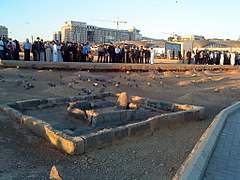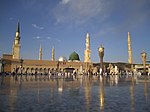Al-Baqi Cemetery
| Al-Baqīʿ | |
|---|---|
ٱلْبَقِيْع | |
Muslim | |
| Owned by | Ministry of Islamic Affairs, Dawah, and Guidance |
Jannat al-Baqi (
Al-Baqi is reportedly founded by
History
When Muhammad arrived in Medina from Mecca in September 622 CE, al-Baq was a land covered with boxthorn. According to historical records, after Muhammad’s arrival, the houses of Medina developed near al-Baqi', which was therefore considered the public tomb. The bramble growth was cleared, and the place was consecrated to be the future cemetery of the Muslims who died in al-Madina.[1] Additionally, al-Baqi’ was introduced as a location with Nakhl on its east side and houses on its west side. In fact, before its demolition, al-Baqi’ was situated behind the houses in the city.[3]
During the construction of the Prophet’s Mosque on the site he purchased from two orphan children after his migration from Mecca to Medina,
While Muhammad was outside Medina for the
Shortly after Muhammad arrived from Badr,
When his youngest son
Initially, the third caliph,











